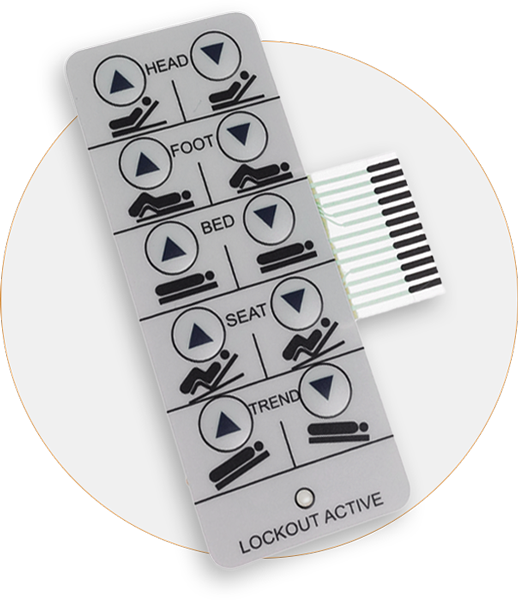Trick Advantages of Using a Membrane Switch in Industrial Applications
Trick Advantages of Using a Membrane Switch in Industrial Applications
Blog Article
Recognizing the Performance of Membrane Layer Switches for User Interface Tools
The capability of membrane layer switches over represents a substantial improvement in interface design, incorporating effectiveness with aesthetic convenience. These buttons operate with a multi-layered structure that converts customer communications right into electric signals, enabling both compact formats and strength against ecological elements. As markets increasingly focus on individual experience, understanding the subtleties of membrane layer button technology comes to be vital. What effects do these improvements hold for future applications, and how might they redefine individual interactions across various gadgets?
What Are Membrane Layer Buttons?
Membrane layer buttons are cutting-edge interface tools that promote individual interaction with electronic tools. These flexible elements include numerous layers, consisting of a visuals overlay, spacer, and a published circuit layer. The design enables for a seamless combination into various electronic devices, enhancing both the aesthetic and functional aspects of interface.
Membrane layer buttons are typically used in a wide variety of applications, from home devices to industrial equipment and clinical devices. Their construction normally includes a thin profile, making them an optimal choice for portable styles. The tactile comments provided by these switches can be engineered to fulfill particular individual choices, ensuring reliable communication in between the individual and the gadget.
Longevity is an additional considerable advantage of membrane layer buttons, as they are resistant to dirt, moisture, and chemicals, which enhances their life expectancy sought after environments. Additionally, these buttons can be customized in regards to form, size, and visuals layout, enabling branding and user-specific attributes. On the whole, membrane switches over represent a sensible option for enhancing customer experience in electronic devices, integrating capability with aesthetic charm in an efficient manner.
How Membrane Layer Switches Work
Operating on a straightforward concept, membrane changes use a layered construction to register individual input effectively. Each switch contains multiple layers, consisting of a published circuit layer, a spacer layer, and a top visuals layer, which are made to work with each other flawlessly. When a customer presses the top layer, it compresses the spacer layer, bringing the conductive components of the circuit layer into contact with each various other.
This call produces a shut circuit, signaling the gadget to execute a details function. The design permits for various arrangements, including tactile responses, which can enhance the user experience by giving a physical feeling upon activation. The products used in membrane layer buttons typically consist of flexible substratums, such as polyester or polycarbonate, which ensure resilience and durability versus wear and tear.

Trick Benefits of Membrane Layer Switches

An additional significant benefit is their density. Membrane switches are thin and light-weight, which allows producers to conserve room in their devices without giving up performance. This function is particularly advantageous in applications where weight and volume are vital considerations.
Furthermore, membrane layer switches are resistant to dust, wetness, and chemicals, boosting their resilience. This durability expands their lifespan and minimizes the requirement for frequent substitutes, causing expense savings in time.
Additionally, the tactile feedback provided by membrane buttons can be optimized to improve user communication. They can consist of attributes such as elevated buttons or distinct clicks, boosting functionality and individual experience.
Applications Throughout Industries
Interface devices utilizing membrane switches are prevalent in a vast range of sectors, showcasing their adaptability and capability. Membrane Switch. In the clinical sector, membrane layer buttons are essential to gadgets such as diagnostic tools and person tracking systems, where their sturdiness and ease of cleaning are crucial for keeping hygiene criteria. Similarly, in the auto market, these buttons are utilized in control panel controls and infomercial systems, giving a sleek and contemporary interface for users.
Furthermore, the customer electronic devices industry gain from membrane switches in home appliances and portable devices, see this website where compact style and user-friendly interfaces boost user experience. Industrial applications likewise leverage membrane switches for control panels in machinery and automation systems, stressing their toughness and resistance to harsh settings.
In the aerospace and defense sectors, membrane layer buttons are utilized in cabin controls and equipment, where integrity and performance under severe problems are critical. In addition, the video gaming sector significantly incorporates membrane buttons in controllers and arcade devices, adding to an appealing user experience. Generally, the versatility of membrane layer switches over enables their widespread use across many sectors, emphasizing their importance in modern individual interface design.
Future Patterns in Membrane Change Technology

In addition, making use of sophisticated materials, such as polycarbonate and polyester films, is anticipated to rise, providing improved longevity and resistance to environmental stress factors. These materials add to the overall durability of membrane buttons, making them suitable for harsher commercial applications.
Additionally, the incorporation of clever modern technology, including IoT connectivity, will make Get More Information it possible for membrane switches to connect with other tools and systems, assisting in a more interactive user experience. This trend aligns with the expanding need for clever tools across numerous sectors, from medical care to consumer electronics.
Last but not least, modification choices are anticipated to expand, allowing suppliers to develop bespoke services customized to specific customer requirements and preferences. These growths will position membrane switches as crucial elements in the evolution of individual interface innovation.
Verdict
To conclude, membrane switches over represent a pivotal development in individual interface innovation, using a reliable and versatile remedy for diverse electronic applications. Their split construction promotes compact design, while features such as responsive responses improve user interaction. The resilience versus environmental factors better strengthens their energy across numerous industries. As advancements in material science and touch sensing innovations proceed, the performance and applicability of membrane buttons are expected to broaden, strengthening their value in modern electronic devices.
Report this page